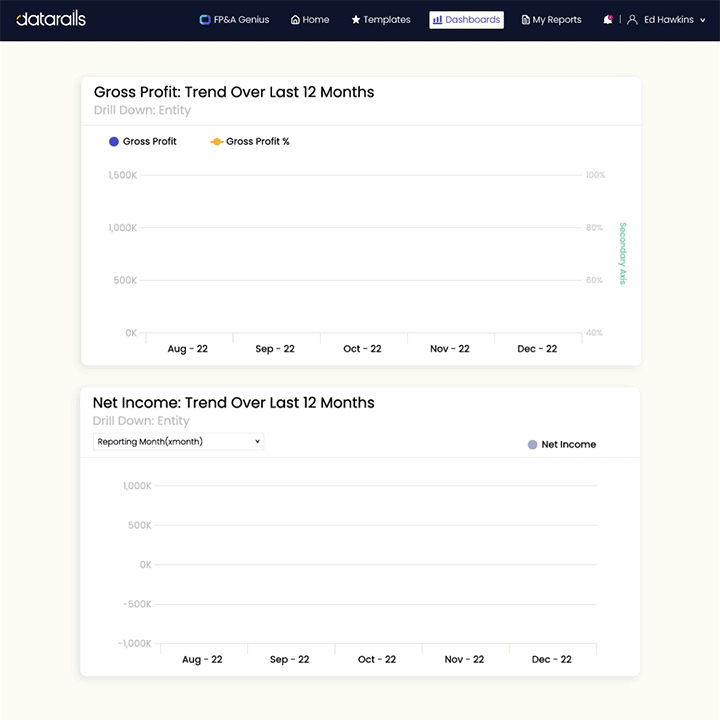
Sloane Kolt is head of Datarails Labs which has announced features transforming Financial Planning and Analysis. Most recently the Labs launched AI-powered FP&A Genius “The ChatGPT for the CFOs Office”. The world’s first generative AI tool for FP&A offers unprecedented instant insights about budgets, forecasts, variance and spend.
In this interview Sloane sits down to discuss her FP&A career including companies such as Pernod Ricard and Hunter Douglas, the parts of finance she wants to fix, and how AI is already transforming the CFO’s office.
1. Can you tell us about your career progression in finance?
I started at a mid-sized family-owned company in accounting. It was supposed to be temporary but ended up being where I learned the foundation that I still operate from to this day. I reported to the CFO and was so inspired by him. Luckily he asked me to stick around in a jack-of-all-trades type finance role.
The company was later acquired by DST Systems (now SS&C Technologies) and I learned a lot about managing change, due diligence, and sell-side M&A integration early in my career.
I later worked at large enterprises like Pernod Ricard and Hunter Douglas and also growing businesses like Datarails.
Over the years, I have been fortunate enough to have both breadth and depth of experience having lived in the trenches of controllership, operations/supply chain finance, commercial finance, FP&A, and even outside of finance in operations.
2. What made you leave finance and consider a different path?
Finance is an incredible foundation that I use to this day. Furthermore, financial literacy is fundamental in business, and essential for those in, or aspiring to, senior leadership positions. Grasping the language of finance and accounting enables leaders to gauge the effectiveness of their strategies and understand the economic impact of their decisions. My finance experience has honed my understanding of the mechanisms that drive business and really brought opportunity cost front and center for how I approach decision-making. It’s great to fantasize about all of the things you want to do, but at the end of the day, capital isn’t limitless which means success requires focusing on what is worth the investment of time, talent, and financing.
However, I love what tech can do for business (including in finance). I’ve found that I love the technical aspects of products and finding viable business models for different types of customers and users. I’ve always been an automator and moving into tech was a natural progression.
When Datarails knocked on my door, it was a huge risk, but the calculation paid off and has been, to date, the best bet I’ve made!
3. How has FP&A changed since you first started your career? Give an example of how you do a task differently today compared to how you did it at the beginning.
The sheer amount of data that can (and should) inform finance has increased exponentially and it means that in order to properly analyze all of it, we need computational assistance. The role of data science has completely changed the landscape, particularly for Enterprise companies. It’s impossible, not to mention extremely unpleasant, for humans to review every transaction that a business has. With the support of AI, finance teams can be sure that there aren’t trends that they are missing. Beyond individual organizations’ data, FP&A has expanded to include analysis of broader industry, macroeconomic, and even weather data in their planning and analysis. Companies have been incorporating AI into their models with ever-improving results at a fraction of the time of traditional methods. Another big shift is moving away from the back-and-forth budget template email saga. I think many finance folks have residual nightmares from having to keep track of the correct version. Thankfully we have tools today (shameless plug for Datarails here) that make this a distant memory.
4. How did you start working on AI?
I’ve been in the AI camp for almost 10 years. Back in 2013, I ran my own company, which aimed to disrupt the recruiting and talent market. Although recruiting has changed in the last 15 years, the problems that existed then still exist today. While we all put our best foot forward during the hiring process sometimes our best instincts fall flat. As humans, we largely operate off of bias when evaluating potential hires/companies. Utilizing AI was a great way to remove some of the human error. People make these big decisions based on what is effectively a couple of “dates” and we knew AI could bridge the gap between these first impressions and reality. Thinking back, I was pretty naive at the time, but that experience served as fertile ground for learning and I’m excited to be applying it once again.
At Datarails, good timing combined with my desire to move to work more on the Product / R&D side of the business brought AI back into my professional life. I am extremely grateful to be a part of Datarails Labs, our very own AI skunkworks. And while I’m not an AI expert – no one would ask me for lessons on how to engineer their Transformer (the architecture behind large language models), I’ve really enjoyed being able to work deeply with AI again. What’s been most interesting for me are the limits of current AI technologies and pushing where autonomous agents can go, especially when combined with other kinds of Artificial Intelligence.

5. In what areas do you feel that AI is important in FP&A? How will it change it?
AI holds immense potential for FP&A and broader finance and accounting applications. We’re on the cusp of unlocking the full strategic potential of financial professionals as true business partners — arguably the most transformative and valuable skill a finance professional can offer. Mundane tasks will be exponentially reduced. This further accelerates the transformation we’ve already seen, effectively positioning finance professionals as the strategic core of the business rather than the “bean counters” of yore.
6. Do you think it can help reduce manual work, accountant shortages, long hours, and all the other current finance problems?
Manual work, yes – I anticipate a drastic change. We are already seeing it now with FP&A tools and AI is going to complement and intensify the shift already underway. In terms of long hours, it depends on what you mean by that. Will it change how finance folks use their time? 100%. I have no doubt about that. In finance specifically, it remains to be seen how something like overall hours will change. Finance teams probably won’t be having midnight sessions at month end because presentations have to be redone for yet another version, but people working in finance will be ever more intertwined with their business partners, be it the CEO or department leaders. My prediction? Finance workers will be very busy, it will just look different than it looks today – a lot more strategic work, a lot less grunt work.
7. Can you explain simply what DR is doing with AI and how it can help customers or future customers?
Our team is working on some really cool AI products. Without giving too much away – we want to make finance more accessible for finance users and business leaders. People working in finance are often put in a position of having to be an intermediary – they hold the keys to financial information. The reality of that is that finance folks are often on-call, they need to perform data retrieval on demand, even when it takes some time to compile and manipulate data to get there. It’s not the best use of their time. With a goal of taking “middle-person” out of the unofficial finance job description, we are creating solutions that use conversational AI (among other things) to bridge that information gap and keep finance folks focused in areas where they truly lead in creating value. We’ve already released FP&A Genius which is a conversational gateway for our customers to quickly access their data and gain insights and I’m very excited for what comes next.
We envision finance professionals using these tools to enhance their work, get quick answers that give a boost to their analysis, and make better recommendations with their business partners. It’s safe to say that economic volatility is here to stay. People working in finance as well as their business partners need fast solutions that will help them weather the storms and identify opportunities so they can take advantage of them in an effective and timely way.
Computer scientists have been working on AI for almost 70 years, but in many ways, it’s still in a nascent stage. Even so, things that we used to consider artificial intelligence, are now taken for granted and no longer label it as such. Take many photos apps for example. If you’ve ever searched your photos for a specific person, animal, or thing, you’ve utilized fairly complex artificial intelligence, but we don’t really speak about it (for those interested in researching further, Convolutional Neural Nets have driven image recognition for years). One day, the innovations we are speaking of today will be taken for granted as the norm.
One of the big concerns with the current state of AI, notably in large language models (think ChatGPT) is the propensity to “hallucinate” for lack of a better term. Because these models are simply predicting what the next word should be given the previous words, they don’t always return accurate/logical information.
Given the high percentage of finance experts working at Datarails, we know what it’s like to be sitting in a stakeholder meeting and have the wrong information so we are working hard to put in guardrails to make sure our customers can trust their data.
8. What do you think FP&A will look like in 5 or so years?
Something I’ve learned at Datarails is that when things are moving fast, 5 years is a very long time. I expect the next 5 years to be transformative, not just for finance, but throughout the business world, in healthcare, in law, really – you name it. AI is going to have a profound impact on our society in both good and bad ways. It’s an amazing technology and I’m delighted to be able to work with it in a way that will produce a fundamental and positive shift in the lives that finance people lead. Let’s be real – no one wants to sit and do hours and hours of manual repetitive grunt work. It’s time we take the bright minds working in finance and focus them on building businesses.
9. Any recommendations for folks wanting to learn more about AI, but are overwhelmed with where to start?
If I had to pick one resource that provides a way to understand the landscape in an approachable way, I’d highly recommend reading: “Artificial Intelligence, A Guide for Thinking Humans” by Melanie Mitchell at the Santa Fe Institute. Dr. Mitchell provides an excellent primer without heavy math.